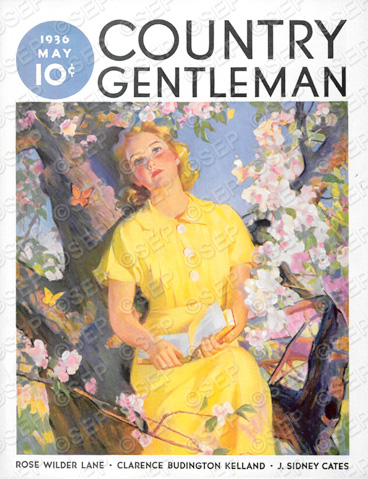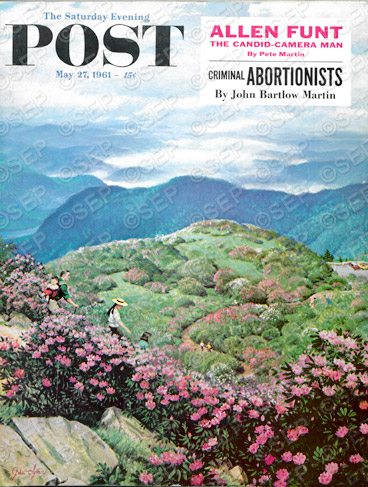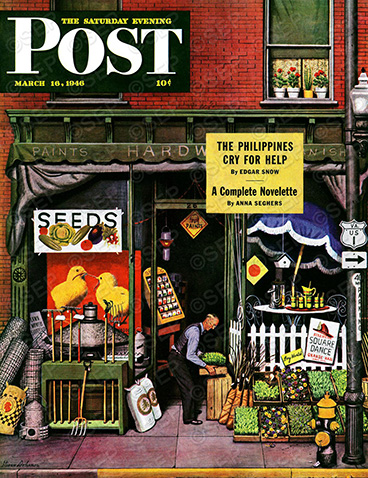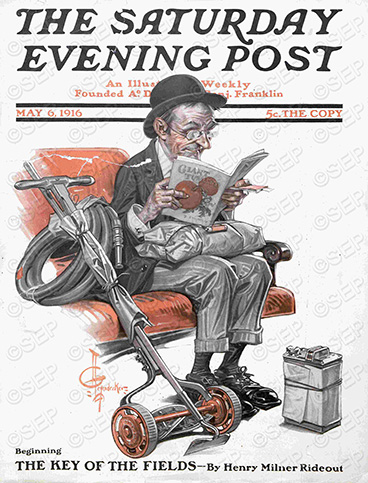Classic Covers: A Hint of Spring
We are over it! We’re through with snow and slush, and we’re seeking hints of spring from our finest cover artists: Rockwell, Leyendecker, Dohanos, Falter, Clymer, and more.
Shoveling Floral Shop Sidewalk
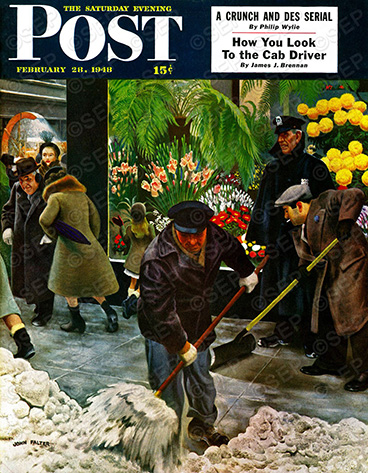
Shoveling Floral Shop Sidewalk
John Falter
February 28, 1948
“It was cold in New York,” Post editors say of this John Falter (1910-1982) cover, “and the cagey artist did most of his investigating behind glass, riding up and down on a Madison Avenue bus.” Painting the scene, Falter figured the frozen-faced workers would get an ironic chuckle from the fact that inside the flower shop window it is spring. Or perhaps not. Editors also had to note that Falter delivered his picture to the Post “just before the first of the winter’s oversize snowstorms hit New York. Then the artist hauled out for Arizona, where you may enjoy scenes like this in comfort.”
Springtime, 1935 Boy with Bunny
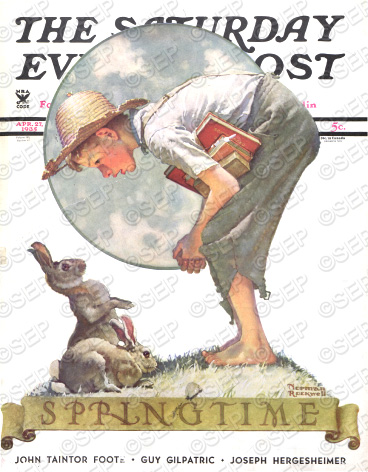
Springtime, 1935 Boy with Bunny
Norman Rockwell
April 27, 1935
“You can’t buy a straw hat and make it look old by rubbing dirt in it,” Norman Rockwell (1894-1978) wrote in My Adventures as an Illustrator. “A hat has to be worn in the sun and sweated in and sat on and rained on. Then it’ll be old. And look it.” In 1935 Rockwell was asked to illustrate Mark Twain’s The Adventures of Tom Sawyer and The Adventures of Huckleberry Finn, and he took the costuming very seriously. Desperately needing the right hat for Huck, he found just the thing in, appropriately, Hannibal, Missouri, Twain’s hometown. He spotted “a man walking along the road wearing a straw hat in a beautiful state of decay” and managed to buy it from him. Before long he ended up with a carload of clothes, “all old and rotten, battered, tattered, and splotched.”
Folks around Hannibal no doubt talked for a long time about that crazy guy who paid good money for their old duds, but the book illustrations were done to everyone’s satisfaction. And, like the boy greeting spring (left) with his worn hat and raggedy pants, some Post covers reflected the “Huck Finn look.”
Reading Among the Blossoms
F. Sands Brunner
Country Gentleman
May 1, 1936
Despite the fact that F. Sands Brunner (1886-1954) was very much a rugged outdoorsman who enjoyed camping, canoeing, and mountain climbing, most of his paintings reflect domesticity with adorable children and lovely women. This 1936 work from Post sister publication Country Gentleman is a case in point. The rich color and skillful use of lighting are typical of Brunner’s work. The Boyertown, Pennsylvania, native painted three Country Gentleman and two Post covers.
Appalachian Rhododendrons
John Clymer
May 27, 1961
Nature took over on a grand scale in most of John Clymer’s (1907-1989) 80 Post covers, and people were secondary. In fact, the viewer almost has to squint to see the family consisting of Dad with baby on his back, Mom in straw hat, and daughter leading them along the trail to Craggy Pinnacle near Asheville, North Carolina. Clymer told Post editors, “Sections of the trail wind through 10-foot-high rhododendrons, and the ground is carpeted with the rich pink petals of the flowers that have fallen.”
“These floriferous slopes look their best in mid-June,” editors noted in 1961, “as they did when the Catawba and the Cherokee held sway in the Carolinas. But if the scenery of the area has not changed much, the people have. What self-respecting Indian brave would have toted a papoose on his back?”
Hardware Store at Springtime
Stevan Dohanos
March 16, 1946
Artist Stevan Dohanos (1907-1994) loved hardware stores, and editors informed us that “the store he has painted affectionately for this week’s cover is a composite of many where Dohanos himself has obeyed the impulse, very strong in the spring, to buy a lot of new garden tools.” They warned, however, “this equipment buying is by all odds the most popular phase of gardening, for on a bland spring day there is nothing like the feel of a good rake or hoe in your hand—in the hardware store.”
Ready to Garden
J.C. Leyendecker
May 6, 1916
This gentleman has made his trip to the hardware store and is hauling those spring purchases, lawn mower and all, back by public transportation. Perhaps more surprising is that the illustration is by the great J.C. Leyendecker, the man responsible for those chiseled Arrow Collar men who “haunted several generations of less fortunate-mankind,” according to David Rowland in a 1973 issue of the Post. In Leyendecker’s 40-plus years with The Saturday Evening Post, he showed amazing versatility as an illustrator, depicting subjects varying from elegant to comical in more than 300 covers.
Classic Covers: The Grocery Store
Remember turning in pop bottles for change? How about having a few cents for candy and taking forever to decide? These Post covers remind us how much shopping has changed.
Lunchtime at the Grocery by Albert W. Hampson
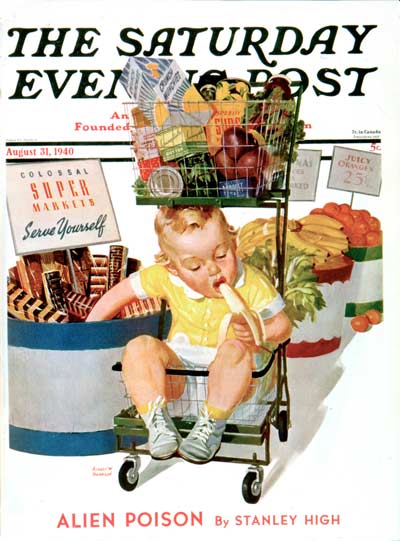
Lunchtime at the Grocery
from August 31, 1940
The grocery cart was only a 3-year-old invention when this 1940 Post cover was painted. Invented in 1937, the “double basket” didn’t immediately catch on. People were used to carrying a woven basket, but to some women the cart seemed a bit much. Older people were afraid they’d appear feeble and men wanted to appear manly, as if handling a few groceries were no big deal. The inventor of the cart, Sylvan Goldman, finally hired models of all ages and both sexes to use the carts while shopping. It caught on enough by 1940, that a Saturday Evening Post cover featured the now ubiquitous baskets on wheels.
Thoughtful Shopper by Norman Rockwell
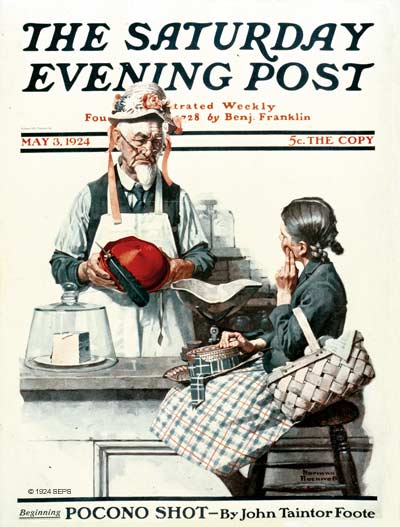
Thoughtful Shopper
May 3, 1924
Before the days of the shopping cart, grocers went around the store fetching items according to your list. According to Norman Rockwell’s 1924 cover, sometimes they had to do so much more. The gentleman in this painting was J. L. Malone, who appeared in at least one other Rockwell cover. The artist appreciated Malone’s reading voice and the model sometimes read aloud for hours while Rockwell worked on an illustration such as this. The usual fare? Classic Dickens.
Penny Candy by Frances Tipton Hunter
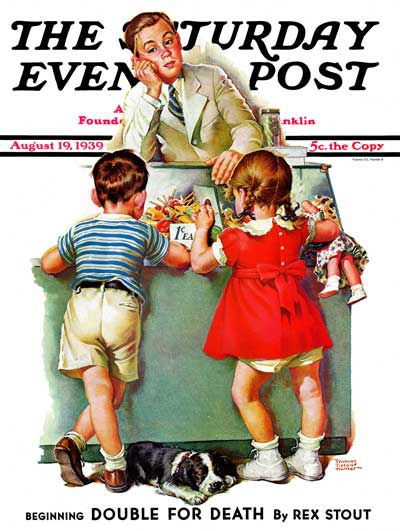
Penny Candy
August 19, 1939
No one promised the grocer an exciting career. Even the dog has fallen asleep while the children try to decide which candy to get. In 1939, a penny was a lot to a little kid. For more covers by Frances Tipton Hunter — guaranteed sweeter than penny candy — see The Art of Frances Tipton Hunter.
Grocery Line by Stevan Dohanos
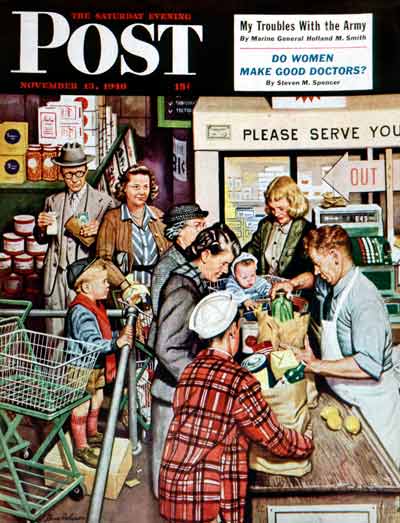
Grocery Line
November 13,1948
As sure as you just want to pay a bite to eat and get on with your day, a slow-moving line looms ahead. Artist Stevan Dohanos had everything he needed in this painting except for just the right guy to portray the stalled shopper. To heck with it; the artist just went ahead with his summer vacation in Martha’s Vineyard. There he spotted a fellow vacationer in shorts and a fishing hat, yelled, “Hey, wait!” and proceeded to explain his Saturday Evening Post cover predicament. Sure, I’ll pose, the stranger said, and headed home to put on his city clothes. The man, H.R. Knickerbocker, was already known as an illustrious war correspondent, but now he was immortalized on a Post cover. The shopping carts are unique, quite different from the below cover from three years later.
More Money, Honey by George Hughes
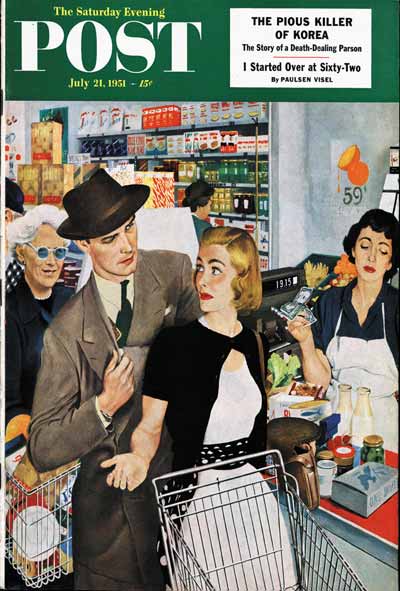
More Money, Honey
July 21, 1951
This 1951 cover with the sleek metal cart looks more like today’s groceries, except perhaps for the milk bottles and the gentleman’s fedora. Oh, and the fact that she’s using a strange thing called cash rather than a credit or debit card.
Babies and Bananas by Stevan Dohanos
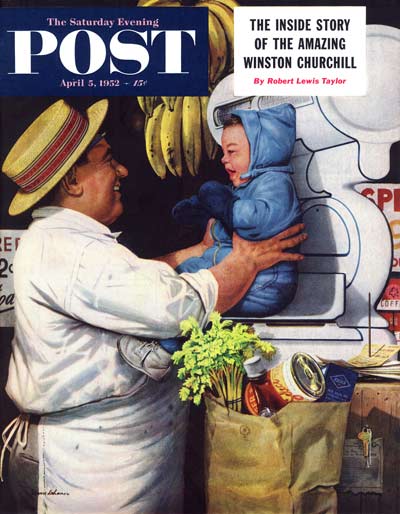
Babies and Bananas
April 5, 1952
This is not an example of how a grocery store operates these days, but this 1952 cover is a fine example of why artist Stevan Dohanos is a Post favorite. Dohanos had done some farm scene murals for the grocery store and decided to use the actual grocer in a painting destined for The Saturday Evening Post. The artist just happened to have a cute baby to use for the cover — his own little tyke, Tony.
